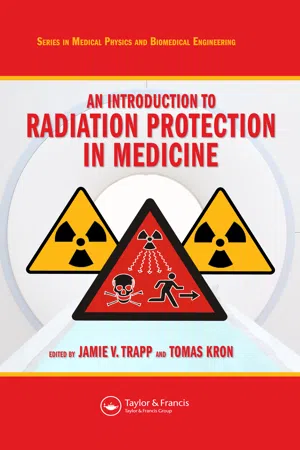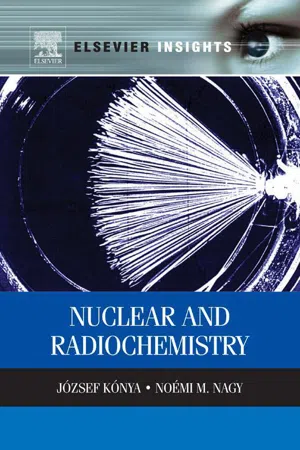Physics
Alpha Beta and Gamma Radiation
Alpha, beta, and gamma radiation are types of ionizing radiation. Alpha radiation consists of helium nuclei, beta radiation involves high-energy electrons or positrons, and gamma radiation is a form of electromagnetic radiation. These types of radiation differ in their ability to penetrate materials and their ionizing power, with alpha being the least penetrating and gamma being the most penetrating.
Written by Perlego with AI-assistance
Related key terms
1 of 5
11 Key excerpts on "Alpha Beta and Gamma Radiation"
- Jamie V. Trapp, Tomas Kron, Jamie V. Trapp, Tomas Kron(Authors)
- 2008(Publication Date)
- CRC Press(Publisher)
Gamma rays originate from changes within the nucleus, that is, reconfiguration of the nucleons to achieve a lower-energy configura-tion. Because nuclear changes normally involve greater energy transitions than electronic transitions, gamma rays are frequently, but not always, of greater energy than x-rays. 2.1.4 Alpha Radiation Alpha radiation is the emission of two protons and two neutrons in the form of a 4 He nucleus from the parent atom. Alpha decay occurs with dis-crete energies, rather than as a continuous spectrum, and this energy is in the form of kinetic energy of the alpha particle and the recoiling daugh-ter nucleus. Conservation of momentum determines how much energy the alpha particle and the daughter will carry, with the alpha particle carrying most of the decay energy. 2.1.5 Beta Radiation Beta radiation, or beta decay, is the emission of either an electron or a posi-tron from the nucleus of an atom (a positron is a positively charged electron, i.e., the antiparticle of the electron) as shown in equation (2.3a) and (2.3b). A variation is the process of electron capture , where the nucleus captures an inner shell electron as shown in equation (2.3c) and is usually accompanied by the emission of x-rays as the vacancy in the inner shell is filled, and if the An Introduction to Radiation Protection in Medicine nucleus de-excites after electron capture, then one or more gamma photons will also be emitted. A Z X A Z Y e → + + − + 1 0 1 υ (2.3a) A Z X A Z Y e → + + − + 1 0 1 υ (2.3b) A Z X e A Z Y + − → + + 0 1 1 υ (2.3c) The extra terms, υ and υ seen in equation (2.3a) and (2.3b), relate to the emission of an elementary particle called a neutrino, which always accompa-nies beta decay and is necessary to conserve energy and momentum. Unlike alpha decay, which is always of a discrete energy, beta particles are emit-ted from an atom with a continuous spectrum of energies.- Morris Hein, Scott Pattison, Susan Arena, Leo R. Best(Authors)
- 2014(Publication Date)
- Wiley(Publisher)
18.2 • Alpha Particles, Beta Particles, and Gamma Rays 421 Radioactivity is believed to be a result of an unstable ratio of neutrons to protons in the nucleus. Stable nuclides of elements up to about atomic number 20 generally have about a 1 : 1 neutron-to-proton ratio. In elements above number 20, the neutron-to-proton ratio in the stable nuclides gradually increases to about 1.5 : 1 in element number 83 (bismuth). When the neutron-to-proton ratio is too high or too low, alpha, beta, or other particles are emitted to achieve a more stable nucleus. 18.2 ALPHA PARTICLES, BETA PARTICLES, AND GAMMA RAYS Describe the change in atomic number or atomic mass associated with emission of an alpha particle, beta particle, and gamma ray. The classical experiment proving that alpha and beta particles are oppositely charged was performed by Marie Curie (see Figure 18.1). She placed a radioactive source in a hole in a lead block and positioned two poles of a strong electromagnet so that the radiations that were given off passed between them. The paths of three different kinds of radiation were detected by means of a photographic plate placed some distance beyond the electromagnet. The lighter beta particles were strongly deflected toward the positive pole of the electromagnet; the heavi- er alpha particles were less strongly deflected and in the opposite direction. The uncharged gamma rays were not affected by the electromagnet and struck the photographic plates after traveling along a path straight out of the lead block. KEY TERMS alpha particle (a) beta particle (b) gamma ray (g) + – Electromagnet Beta Photographic plate Gamma Alpha Radioactive source Lead block Figure 18.1 The effect of an electromagnetic field on alpha particles, beta particles, and gamma rays. Lighter beta particles are deflected considerably more than alpha particles. Alpha and beta particles are deflected in opposite directions. Gamma radiation is not affected by the electromagnetic field.- eBook - ePub
- Ritesh Kohale, Sanjay J. Dhoble, Vibha Chopra(Authors)
- 2009(Publication Date)
- Bentham Science Publishers(Publisher)
2 ]. Radioactive decay (also known as nuclear decay, radioactivity, radioactive disintegration or nuclear disinte- gration) is the process by which an unbalanced atomic nucleus drops energy by particle emission. The decaying nucleus is called the parental radionuclide, and the process produces at least one daughter nuclide. Excluding gamma decay or internal conversion from a excited nuclear state, the decay is a nuclear transformation ensuing in a daughter containing an altered number of proton orneutrons (or both). When the number of protons changes, an atom of a different chemical constituent is generated [3 ].A material encompassing unbalanced nuclei is deliberated radioactive. Three of the most communal categories of decay are alpha decay (α -decay), beta decay (β-decay), and gamma decay (γ-decay), all of which include releasing one or more particles or photons. The weak force is the mechanism accountable for beta decay, while the other two are ruled by the usual electromagnetic and tough forces [4 ].1.1. Alpha (α) Rays
They could barely pass through a single sheet of paper. Deflected in a magnetic field as they are positively charged particles.1.2. Beta (β) Rays
They can pass through about 3mm of aluminium metal sheet. Deflected in the magnetic field as they are negatively charged particles.1.3. Gamma (γ) Rays
They can pass through several centimetres of lead or concrete walls. They do not deflect in a magnetic field as they are charge-less particles.Following Fig. (Fig. (7.1)) Schematics of Alpha, Beta and Gamma rays.) gives a general idea about their existence and nature.7.12. Alpha, Beta and Gamma Decay
2.1. Origin of Alpha Decay
- eBook - PDF
Basic Physics Of Radiotracers
Volume II
- Earl W. Barnes(Author)
- 2017(Publication Date)
- CRC Press(Publisher)
In time it was determined that there were three types of radiations that accounted for the phenomenon that was called radioactivity. The three types of radiations were named: 1. Alpha particles (cr) 2. Beta particles ( ß) 3. Gamma rays (y) The substances that emit one or more of these radiations are called radioactive nu clides. Investigations since the early years of this century have established that the three types of radiations originate in the nucleus of certain nuclides, and that (1) alpha par ticles (a) are, in actuality, helium nuclei (2He); (2) beta particles ( ß~ and ß +) are, in actuality, negative and positive electrons (e and e+); and (3) gamma rays (y) are high energy electromagnetic radiations (photons). Radioactive disintegration is a mechanism whereby an unstable nucleus can give up energy in order to achieve a configuration of greater stability. II. THE RADIOACTIVE DECAY CURVE If N represents the number of radioactive nuclei in a certain sample at a certain time, then the rate at which the nuclei in the sample decay is given by -dN dt where the minus sign signifies that the number of nuclei in the sample decreases with time. The quantity — (dN/dt) is called the activity of the sample: -dN ACTIVITY = -------dt The activity of a radioactive substance is often measured in terms of the curie, which is defined as follows: Activity is sometimes measured in terms of the rutherford, which is defined as fol lows: disintegrations per second 39 1 rutherford (rd) = IO6 disintegrations per second (1 mrd = IO-3 rd = IO3 disintegrations per second) (1 ¡did = IO-6 rd = 1 disintegration per second) The disintegration of radioactive nuclei is a random process. However, when a large number of nuclei are considered it is found that the activity of a radioactive substance is directly proportional to the number of radioactive atoms present, i.e.: where À is a proportionality constant called the radioactive decay constant. - eBook - PDF
- John A. S. Adams, Paolo Gasparini(Authors)
- 2013(Publication Date)
- Elsevier(Publisher)
Gamma rays are commonly associated with this kind of nuclei. A typical example is ^^^Bi. This nuclide is a member of the ^^^Th natural series and undergoes branched decay, i.e., it decays by α emission to ^osjj - emission to ^^^Po. Let us con- sider, as an example, only the alpha decay. The emitted alpha particles can be gathered into different energy groups. Table I T A B L E I D I F F E R E N T E N E R G E T I C G R O U P S OF A L P H A P A R T I C L E S F R O M ^^^Bi and by G A M M A E M I S S I O N 7 and, upon substitution with eq.(1.2): = \Mv\\ + M/M„) (1.4) Therefore the alpha disintegration energy differs from the alpha particles energy by a factor of (1 + M / M J . The differences among the alpha disintegration energy relative to the most energetic alpha emission (i.e., 6.084 MeV) and those relative to the other emissions are given in Table I. Some of the gamma emissions from ^^^Bi can be gathered into the following energy groups: 0.040, 0.144, 0.164, 0.288, 0.328, 0.432, 0.452, and 0.472 MeV. A comparison with the disintegration energies reported in Table I shows that they match closely the energetic differences corresponding to difTerent groups of alpha emissions. An hypothesis explaining the meaning of the energetic spectra displayed by primary particles and the way such spectra are bound to gamma emission has been put forward by Gamow in 1930. Today the existence of different energy levels in the nucleus is a major hypothesis of nuclear physics. It is assumed that a nucleus is ordinarily in a state corresponding to the lowest energy level (ground state), but that it can be found for short times in states characterized by higher energies (excited states). When the above reported spectrum is interpreted from this point of view, the most energetic disintegration can be expected to correspond to a transi- tion from the ground state of the parent nucleus (^^^Bi) to the ground state of the daughter nucleus (^^^Tl). - eBook - PDF
- John Mcgervey(Author)
- 2012(Publication Date)
- Academic Press(Publisher)
The early classification of nuclear radiations as alpha, beta, or gamma rays was based on the different behavior of the radiations in passing through matter. It is still useful to retain three categories for discussing the interactions of these rays with electrons in matter, but to generalize the categories as follows: 1. Heavy charged particles—any charged particle of mass greater than the electron mass. The lightest of these is the muon, whose mass is about 200 electron masses. 2. Electrons (positive or negative). 3. Photons—gamma rays or X-rays. Heavy Charged Particles. Except when rare interactions with nuclei occur, a heavy charged particle travels in an almost straight line through matter. It interacts with many electrons, losing a very small fraction of its 11 H. Geiger and E. Marsden, Phil. Mag. 25, Ser. 6, 604 (1913). άΝ(θ) = N 0 ntd 2 16 (8) 13.2 PASSAGE OF RADIATION THROUGH MATTER 481 energy in each interaction, so that it may be considered to lose energy con-tinuously, at a rate which is a continuous function of the kinetic energy of the particle. If the energy loss is continuous, one can define a range which is repro-ducible; that is, a given kind of particle, with a given energy, always pene-trates a given material for the same distance before stopping. 12 Knowledge of the energy loss rate and the relation between the initial energy and the range is useful in many ways. For example, if a particle track is observed in a bubble chamber or in a photographic emulsion, the density of bubbles or of exposed grains along the track is proportional to the rate of energy loss of the particle; this information is often used to identify the particle. Another application is simply to use a range measurement to determine the initial energy of particles whose identity is known. For accurate work, one must determine the range-energy relation experi-mentally. But a rough theoretical analysis enables one to understand the general features of this relation. - eBook - PDF
Radiation Threats and Your Safety
A Guide to Preparation and Response for Professionals and Community
- Armin Ansari(Author)
- 2009(Publication Date)
- Chapman and Hall/CRC(Publisher)
The wave radia-tion includes gamma rays and x-rays.* The particle radiation includes alpha particles, beta particles, and neutrons. Each of these has different properties and protection against them requires different strategies. We briefly describe each form and its properties in this section. Gamma Rays and X-rays Gamma rays and x-rays are electromagnetic waves that come in discrete packets of energy called photons. In the physical world, the shape and nature of x-rays and gamma rays are similar to other, more familiar forms of elec-tromagnetic waves such as radio waves, microwaves, radar, visible light, and infrared. Although this statement is a scientific fact, it can be confusing and a bit misleading. Photons from x-rays or gamma rays interact with matter differently because they pack much more energy than other forms of electro-magnetic radiation—1,000 times more than UV radiation, 1,000,000 times more than infrared radiation, 1,000,000,000 times more than microwaves, and 1,000,000,000,000 times more than radio waves. Because they can penetrate and even pass through objects as they inter-act with them, x-rays and gamma rays are considered penetrating radiation. That is why they are used in medicine to image the inside of the body. They go through the soft tissues with ease and strike the photographic film or plate placed behind or underneath the body. But the bones in the body absorb the x-rays and that creates a shadow (image) on the film. If unobstructed, x-rays and gamma rays can reach the length of a football field (10s of meters) in air before they lose their energy and dissipate. The best material to absorb and stop x-rays or gamma rays is lead—hence the lead apron used in medical offices. Even in a high-level gamma radiation field, a few inches of lead can absorb the radiation and shield from it completely. * The x-rays encountered the most are produced by machines, rather than emitted by radioactive atoms. - eBook - PDF
- Michael F. L'Annunziata(Author)
- 2012(Publication Date)
- Academic Press(Publisher)
1.1. The emission of gamma radia-tion often accompanies radionuclide decay processes that occur by alpha par-ticle emission. Gamma radiation is described in Section III. A of this chapter. The nuclei of daughter atoms of alpha particle-emitting nuclides are often unstable themselves and may also decay by further alpha particle emission. Thus, alpha particle-emitting nuclides may consist of a mixture of radionuclides, e ay he e of he re ati e ab da e i te itie of a ha arti e a d a a ra y e i io are e re ed i er e t be ide the radiatio e er y a e i e N N N all part of a decay chain, as illustrated in Fig. 1.32 further on in this chap-ter. Additional reading on radionuclide alpha decay is available from Das and Ferbel(1994). N o w consider what happens to an alpha particle that dissipates its kinetic energy by interaction with matter. Alpha particles possess a double positive charge due to the two protons present. This permits ionization to occur within a given substance (solid, liquid, or gas) by the formation of ion pairs due to coulombic attraction between a traversing alpha particle and atomic electrons of the atoms within the material the alpha particle traverses. The two neutrons of the alpha particle give it additional mass, which further facilitates ionization by coulombic interaction or even direct collision of the alpha particle with atomic electrons. The much greater mass of the alpha particle, 4 atomic mass units (u), in comparison with the electron (5 X 1 0 ~ 4 u) facilitates the ejection of atomic electrons of atoms through which it passes, either by direct collision with the electron or by passing close enough to it to cause its ejection by coulombic attraction. The ion pairs formed consist of the positively charged atoms and the negatively charged ejected electrons. - eBook - ePub
- Jozsef Konya, Noemi M. Nagy(Authors)
- 2012(Publication Date)
- Elsevier(Publisher)
5
Interaction of Radiation with Matter
5.1 Basic Concepts
As discussed in Chapter 1 , radioactivity was first detected when radiation interacted with material on photographic plates. Further studies of radioactivity have indicated that radiation may interact with matter in many other ways. The ionizing effect of radiation has been recognized very early. It has also been observed that the degree of the ionization strongly depends on the type of radiation. Rutherford called the radiation with the smallest range “alpha radiation,” the radiation with intermediate range “beta radiation,” and the radiation with the highest range “gamma radiation.” The radiation causes transitional or permanent physical and chemical changes in the molecules that interact with the radiation.For the interpretation of these interactions, let us look at how energy transitions from radiation to matter and the ensuing changes. To do this, both particles (radiation) and their interactions with matter have to be classified. The particles can be classified on the basis of their characteristic properties, the charge and rest mass. Accordingly, there are charged and neutral particles, and heavy and light particles (Table 5.1 ).Table 5.1. Classification of ParticlesAs seen in Table 5.1 , the particles, especially their rest mass, cover a large range, and as such, they can participate in various interactions depending on which part of a substance they interact with and on the mechanism type of the interaction. For example, the reaction of radiation with matter can involve the electron orbitals, the nuclear field, and the nucleus. The particles can partially or totally transfer their energy to matter, can be absorbed, or can be scattered elastically or nonelastically. Furthermore, as a consequence to the interaction, the matter undergoes excitation or ionization, or nuclear resonance or nuclear reactions can be induced. The interactions between radiation and matter may be strong, intermediate, or weak. All these possibilities are summarized in Figure 5.1 - eBook - PDF
Green Health
An A-to-Z Guide
- Oladele Ogunseitan(Author)
- 2011(Publication Date)
- SAGE Publications, Inc(Publisher)
It does this by detaching electrons from atoms or molecules—this process is called ioniza-tion, and it is relevant in sustainability terms, as ionizing radiation in sufficient doses has the potential to damage human health. Ionizing radiation must have a sufficiently high energy to be able to interact with the atoms of a target. This rest of this article will concentrate on ionizing radiation, as it has greater potential to impact human health. R 396 Radiation Sources Ionizing Radiation Particles Alpha Radiation Alpha radiation consists of a helium-4 (4He) nucleus that moves at high speed and can penetrate a sheet of paper. Beta Radiation Beta radiation consists of electrons moving and can be halted by a thin sheet of aluminum. Gamma Radiation Gamma radiation consists of high-energy electrons and can be halted by dense materials such as lead or concrete by absorption. Sources of Ionizing Radiation Radiation sources can be divided into natural and man-made. We call the radiation that we receive through exposure to a variety of different radiation sources in everyday life background radiation . At sea level, the average background radiation is 26mrem (milli-rems). There are also man-made sources of radiation that are used for a variety of indus-trial, scientific, medical, and energy generation uses. Types of Ionizing Radiation Cosmic Radiation Radiation that comes from the sun, stars, and outer space is known as cosmic radiation. The Earth’s atmosphere acts as a filter against us receiving high doses of cosmic radiation. Exposure to cosmic radiation depends on altitude; those at higher altitudes will therefore receive higher doses of cosmic radiation. Cosmic radiation contributes about 13 percent of the background radiation level on Earth. Airline flight crews, who spend considerable time at high altitudes, receive a greater dose of cosmic radiation than those of us who spend most of our time on the ground. - Richard A. Matzner(Author)
- 2018(Publication Date)
- CRC Press(Publisher)
radiative transfer equation The linear in-tegrodifferential equation that describes the rate of change with distance of the radiance in a col-limated beam at a specified location, direction, and wavelength; the equation accounts for all losses (e.g., due to absorption and scattering out of the beam) and gains (e.g., by emission or scat-tering into the beam). radio absorption Absorption occurring to radio waves as a result of interaction between an electromagnetic wave and free electrons in the ionosphere. See ionospheric absorption. radioactive Containing isotopes that un-dergo radioactive decay to another isotope, or another element, by emitting a subatomic par-ticle: typically electron (beta particle) or he-lium nucleus (alpha particle). In some cases, the radioactive nucleus undergoes an internal rear-rangement and emits an energetic gamma ray (a photon), without changing its atomic number or atomic weight. radioactive decay The process by which unstable atomic nuclei (radioisotopes) sponta-neously break down into one or more nuclei of other elements. During this process, energy and subatomic particles are released. The radioac-386 radio galaxy tive element is called the parent element, while the element produced by the decay is called the daughter element. There are three major pro-cesses by which radioactive decay occurs: al-pha decay (loss of a helium nucleus, hence the atomic number decreases by two and the atomic weight decreases by four), beta decay (a neu-tron decays to a proton and electron, leading to an increase in the atomic number by one), and electron capture (where an electron is captured and combines with a proton to form a neutron, thus decreasing the atomic number by one). The half-life is the amount of time it takes for one-half of the parent to decay into the daughter. The radioactive decay of isotopes of uranium, thorium, and potassium is responsible for the heating of the Earth’s interior.
Index pages curate the most relevant extracts from our library of academic textbooks. They’ve been created using an in-house natural language model (NLM), each adding context and meaning to key research topics.










